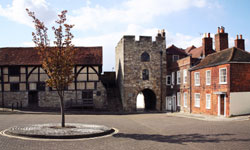
Southampton has always been proud of its links with the sea. It boasts a world class port with over 280 cruise ship movements a year, and is one of the country's leading commercial dockyards.
Southampton, known as 'the gateway to the world', has seen many visits from the world's greatest ocean liners, including the QE2 and the Titanic.
Every year Southampton hosts sailing events, such as the Southampton Boat Show, which attracts tourists from around the world.
The port rose from humble beginnings. The ancient seaport of Hamptun, from which Southampton gets its name, appears in some of the country's earliest historical records. It was in Roman times that Southampton's first port was first built on the River Itchen. Raids by the French on the 14th century led to the construction of forts, or walls, some of which still stand today. Bargate and Westgate are two of the best preserved Medieval Town Walls in the UK.
During the following centuries, Southampton's status as a port grew. It was in 1415 that Henry V sailed to France and Agincourt, and in 1620 English Puritans set sail in search of the New World, on The Mayflower.
Competition from other ports saw trade decrease until the opening of the first dock in Southampton in 1836.
As the steam age progressed, so did the city of Southampton. Adding to this development was the arrival of the railway from London and its shipping industry.
In the 1930s, ships sailed from Southampton around the globe, making it the 'Gateway to the World'. However, the city's success became its downfall, and Southampton was virtually flattened in World War Two, when the Germans became aware of its importance as a major port.
Since then, Southampton has been rebuilt and redeveloped. Southampton remained Britain's leading port in the 1950s and 60s. In 1962 over half a million passengers passed through the port, as well as 4% of imported cargo into Britain. The 1970s saw the port of Southampton changed by some older docks becoming redundant. The number of passengers travelling through the ports of Southampton declined as air travel took off in the 60s. In the 1980s and 90s some of the old docks were converted into areas of shops and offices and marinas.
The 1938 handbook to Southampton Docks states:
"Within comparatively recent years, Southampton has become established as one of the foremost commercial seaports of Britain. The facilities and equipment are among the finest in the world, and the development of the dock system under Railway Company ownership has been marked by an era of progress unparalleled in the history of the port. This great increase in trade has conferred upon Southampton the title of Britain's Premier Passenger Port and also the forth port in respect of the value of freight traffic dealt with."
Today, whilst visitors stop to admire the QE2 harboured in Southampton's docks, it might surprise them to know that Southampton is also the home of the fighter plane "Supermarine Spitfire" or "Spitfire" for short, designed for use by the RAF in World War II.
It's no surprise that Southampton's port became known as the 'Gateway to the World'.